The following review of the CommRadio CR-1 was first published in the August 2013 issue of Monitoring Times magazine.
CommRadio CR-1
By and large, new products on our radio receiver market these days tend to be SDRs or software-defined radios. And it’s a good thing: by reinterpreting radio digitally, it helps ensure that radio will have a place in this century. Moreover, I’m a big fan of SDRs, as they typically offer a lot of performance for the price. In fact, my main receiver these days is the WinRadio Excalibur SDR. It’s the receiver I use for the bulk of my radio recordings as well as for band scanning.
SDRs often look like a small box with power button, antenna connections, usually computer connections, and, well, that’s about it. Many refer to the SDR as a “little black box.” SDRs don’t require a display; rather, they rely on your PC for this and all other functions.
When I first heard that CommRadio was introducing a new SDR, designed and built in the USA, I expected a similar product, in the form of a small black box. Instead, I encountered a display, tuning knob, volume control, and several front panel buttons; in essence, a small stand-alone self-contained battery-operated SDR tabletop receiver! Needless to say, this was unexpected.
First impressions
When I saw the CR-1 for the first time in person, I was simply amazed by its construction. Being a fan of modest, simple designs, the CR-1 is all that––and, for lack of a better word, “cute.”
But don’t be fooled by the “cute:” the CR-1 is a very solid product, and a tough one. The case is made of 20 gauge steel, the front panel from machined aluminium, and the tuning knob from black anodized aluminum. Four substantial resin feet lift the CR-1 a full inch, making the height of the controls comfortably accessible, and providing excellent stability while tuning or pressing buttons on the front face.
The OLED display is small–only measuring 1.5” wide by ¾” high–but the resolution is extremely crisp and easy to read, even at a distance or outdoors. All of the relevant information–frequency, filter width, mode, “S” meter–is accommodated by the modest display.
But what about actual operation? Fortunately, I met Don Moore, president of CommRadio, at the 2013 Dayton Hamvention; he kindly arranged to provide a CR-1 for review.
The CommRadio CR-1, I’m happy to report, is a pleasure to operate. I was able to intuit all of the receiver functions without consulting the owner’s manual even once, a major plus.
To turn on the radio, you simply push the volume control knob, the OLED screen displays a “welcome” message, and you’re in business! The CR-1 also defaults to the last used frequency, mode, and filter settings, which is convenient.
There is no numeric keypad for direct frequency entry, only a tuning knob and buttons which allow you to move through the bands. To compensate for a lack of keypad, the CR-1 has a few unique features:
- The tuning knob is adaptive to your tuning speed––the faster you tune the encoder, the more it will increase its tuning steps.
- Tuning to a specific frequency is easy: simply push the tuning knob once to highlight the frequency cursor, then rotate the encoder to reposition the cursor, and press again to lock the position. You can also use the right/left arrow keys to reposition the frequency cursor.
- By setting the automatic tuning mode, the CR-1 will automatically change the mode and tuning steps to coincide with standard band plans.
- You can set the CR-1 to change bands according to the Amateur Radio or Shortwave Broadcast meter band plans.
The tuning knob, while not large, is appropriately sized for the front panel of the receiver. Though not noticeably weighted, a good thing for a small tuning knob, it’s accurate, responsive, comfortable to use for long periods of time, and the finger dimple is perfectly sized for operational ease.
Switching modes is simply a matter of pressing the dedicated MODE button on the front panel of the CR-1, then cycling through options with the right/left arrow keys.
Filters
The CommRadio CR-1 has a good selection of filters which appear to be well-chosen for the appropriate modes. They are as follows:
- CW: 500 Hz, 1.0, 1.8, & 2.6 kHz
- SSB: 1.8 & 2.6 kHz
- AM: 5, 7.5, 15 & 25 kHz
- Non-Broadcast FM 15 & 25 kHz
- FM Broadcast 200 kHz
The DSP filters have typical sharp skirts; I’ve heard no noticeable ringing in CW. Of course, it would have been a nice touch if the filters were variable, still, the existing filters widths are quite effective.
Audio
The CommRadio CR-1 has a bottom-mounted internal 2.5” diameter commercial grade mylar cone speaker; I find that the downward reflecting speaker with a 1” clearance under the radio make for pleasant audio fidelity. Audio out of the speaker is not as robust as I would like, as it lacks bass response, but the audio produced is clear and crisp. I imagine it would produce intelligible audio even in a noisy environment.
The CR-1 also has a port for an external speaker and an internal amplifier that will deliver 0.8 watts into an 8 ohm speaker.
A separate headphone jack is conveniently located on the left side of the CR-1’s front panel. It delivers about 40 mW into 16 ohms–more than enough for the various headphones I’ve tested it with. Audio fidelity is excellent, though I have noticed a faint white noise in my review unit––a detectable high-pitched hiss via my CR-1-connected headphones. It seems to be present at the same low volume even when the volume control is turned down completely; I suspect it may be some noise in the headphone amplifier. The noise does not interfere with listening at all, but audiophiles will certainly notice it. Note: I have reported this to Don Moore, who believes a future firmware revision to the headphone gain chain will fix this.
Performance
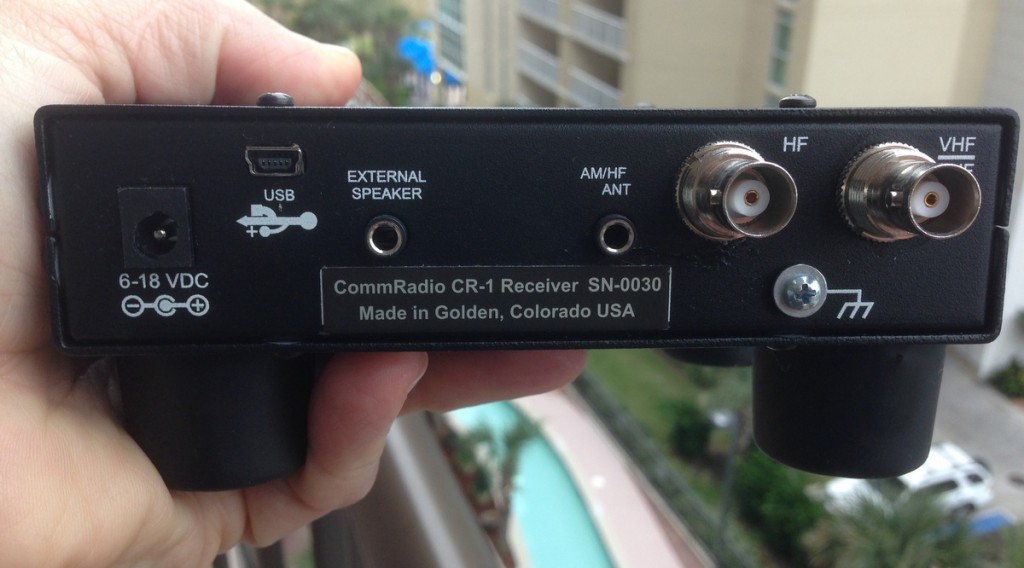
Small form factor, multiple antenna connectors, easy grounding and flexible power options (6-18 VDC via standard or USB inputs) make the CR-1 a perfect travel companion.
Shortwave
The CR-1 is an excellent shortwave receiver. How do I know? I know because I pitted it against every HF receiver and transceiver I have on hand (which amounts to quite a few) and it held its own with regards to sensitivity and selectivity. It ran fairly neck-and-neck with my Alinco DX-R8, which is a remarkably good receiver. I imagine it would hold its own against the Icom R75 as well, although it lacks many of the R75’s features. Yet it’s priced well below a new R75.
While the CR-1’s automatic gain control (AGC) copes with weaker signals and selective fading, I would still like to see among its features selectable USB/LSB sync detection. This is a tool I often use to eliminate an encroaching signal on a sideband. I suppose it’s possible that this could be included in a future firmware revision. My Alinco DX-R8 also lacks sync detection, however, so in fairness I can’t say this feature should be expected at this price point.
Mediumwave/Longwave
The CR-1 could receive all of my local AM stations with ease, but weaker stations were more problematic. This could have been a limitation of my large horizontal delta loop antenna; based on the receiver specs, I imagine this would improve greatly with a proper MW antenna. But it’s worth noting that I was using the HF/MW BNC connector on the back, not the higher impedance port for long wire antennas, which might have produced different results.
On longwave, meanwhile, I found I could copy many of our local airport beacons.
VHF/UHF
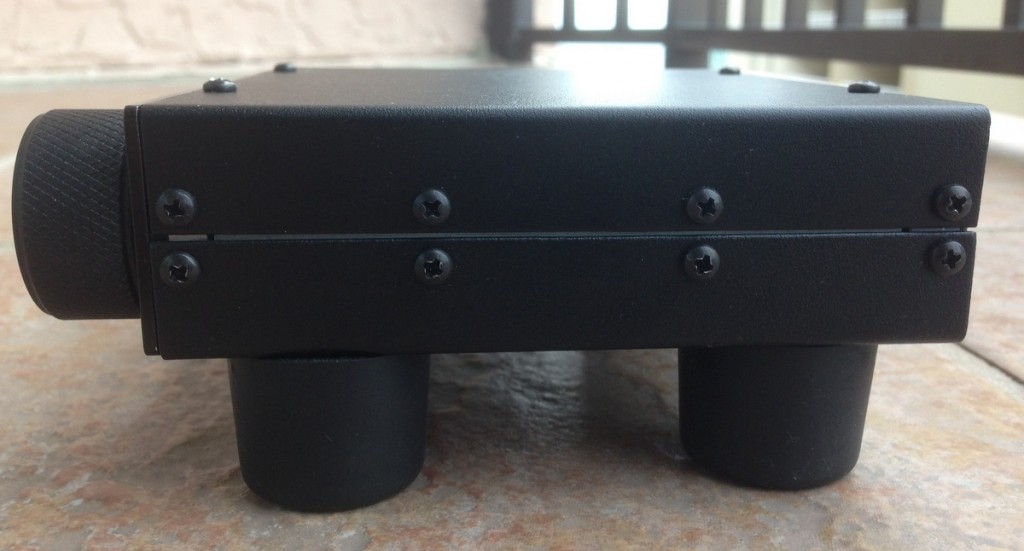 As a bonus, the CR-1 provides wideband continuous coverage from 64 – 225 MHz and 438-468 MHZ, covering the FM broadcast band, Aircraft, Marine, Amateur Radio/Public Service, and GMRS/FRS services.
As a bonus, the CR-1 provides wideband continuous coverage from 64 – 225 MHz and 438-468 MHZ, covering the FM broadcast band, Aircraft, Marine, Amateur Radio/Public Service, and GMRS/FRS services.
While I did not spend a great deal of time exploring these portions of the VHF/UHF spectrum, I did find that the CR-1 easily tuned in all my local FM broadcast stations, my local airport tower frequency, and a few amateur repeaters. The squelch control works very well. Note that the CR-1 has a separate UHF/VHF BNC connector on the back panel. In this review, I simply used a telescopic whip with elbow joint to tune through the band––it’s a great portable accessory.
Summary
I took the following review notes of the CommRadio CR-1 from the moment I first turned it on.
Pros
- Wide RX coverage (LW, MW, SW, FM BC/VHF/UHF)
- Good shortwave sensitivity
- Tuning ease (see con)
- Multiple standard antenna connections (VHF/UHF, HF, HF/MW)
- Simple, intuitive operation; barely requires a manual
- Selectable tuning modes (Amateur/Shortwave) adapt modes/steps to band plan
- Well-chosen filter widths, no ringing (see con)
- Small form factor; compact, sturdy design, perfect for travel
- Built-in battery option, with excellent life (as much as 8-10 hours)
- Separate headphone jack (front) and external speaker jack (rear)
- Flexible power source (USB or 6-18 VDC)
- Future updates will include IQ out
- Durable, tough chassis, secure ports, gold-plated circuit board pads
Cons
- No sync detector
- Bandwidth not variable (see pro)
- No direct frequency entry (see pro)
- No noise blanker
- Very slight white noise hiss can be heard over headphones (slated to be fixed with the firmware update)
The CR-1 puts me in mind of a smaller, updated, and more functional Lowe or Palstar receiver; it has a basic, simple design, yet all of the important features you would expect from a receiver in this class. Moreover, it has the distinct advantage of being an SDR; firmware updates can address customer requests, and functionality added––and tweaked––as needed.
While medium wave performance is fairly average, shortwave sensitivity and selectivity are very good, indeed. The CR-1 copes well with both blowtorch stations and weak signal DX. Though my WinRadio Excalibur has a slightly lower noise floor, the CR-1 holds its own at half the cost.
The CommRadio CR-1 might just be the perfect radio for DXers who like to travel. I travel fairly frequently, and I like to travel light. You’ll never see me check in luggage at an airport; my carry-on bag (with radio, of course) is sized to fit in the most restrictive of overhead compartments, like those in many turbo-prop commuter planes. And the CR-1 fits perfectly in my small carry-on. Though I leave them attached, the feet can be removed, thus reducing its size even further. I don’t even worry about extra protection for it, since it’s built like a little tank!
Best yet, since the CR-1 was designed by an aircraft avionics manufacturer, the built-in battery contains less than 1gm of lithium, therefore is well within the limits regulations currently impose. What’s more, should your battery deplete, the CR-1 can be powered by a standard USB connection.
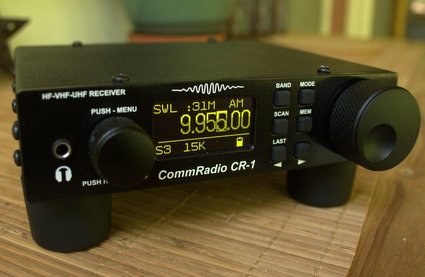 In short, the CommRadio CR-1 is a fun little radio and in my opinion well worth its ?$500 price. Moreover, functionality may further improve; for example, May 2013 firmware updates included a built-in, functional CW reader and international frequency steps. CommRadio is planning an update later this summer which will produce IQ-out via the headphone jack, and on a date to be determined, we may even see IQ from the USB port. If these are added, the CR-1 will connect to your sound card or USB port, and external SDR application functionality will further expand.
In short, the CommRadio CR-1 is a fun little radio and in my opinion well worth its ?$500 price. Moreover, functionality may further improve; for example, May 2013 firmware updates included a built-in, functional CW reader and international frequency steps. CommRadio is planning an update later this summer which will produce IQ-out via the headphone jack, and on a date to be determined, we may even see IQ from the USB port. If these are added, the CR-1 will connect to your sound card or USB port, and external SDR application functionality will further expand.
The CR-1 has a lot of features––and a lot of potential––in a small, sturdy form, always a good formula for a successful radio. And because of this, even though I currently have a number of portable receivers and transceivers, I will add the CR-1 to my radio collection.
Update: I now own a CommRadio CR-1 and have used it many times while travelling. What I love about the CR-1 is that it gives me tabletop receiver performance in a small, sturdy form factor and can literally operate for hours on a fully-charged internal battery. I have also completed a couple of firmware updates, which are multi-step, though still rather simple. CommRadio has been adding functionality and tweaking performance on the CR-1 since its release, which is most encouraging.
You can purchase a new CommRadio CR-1 directly from CommRadio or Universal Radio.
Update (15 November 2013): Please note that since this review was first published, CommRadio has become a sponsor of the SWLing Post. We thank them for their support!

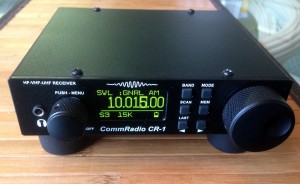
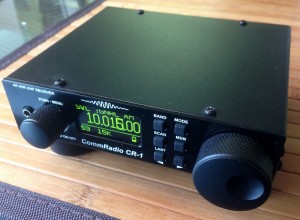
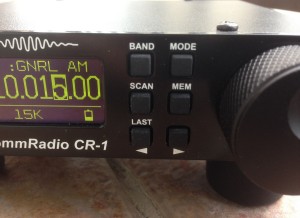
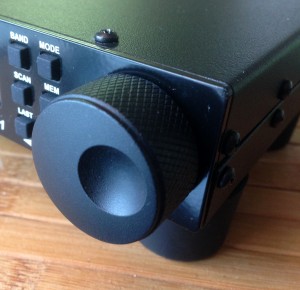
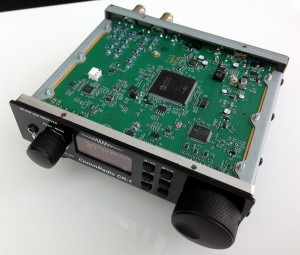
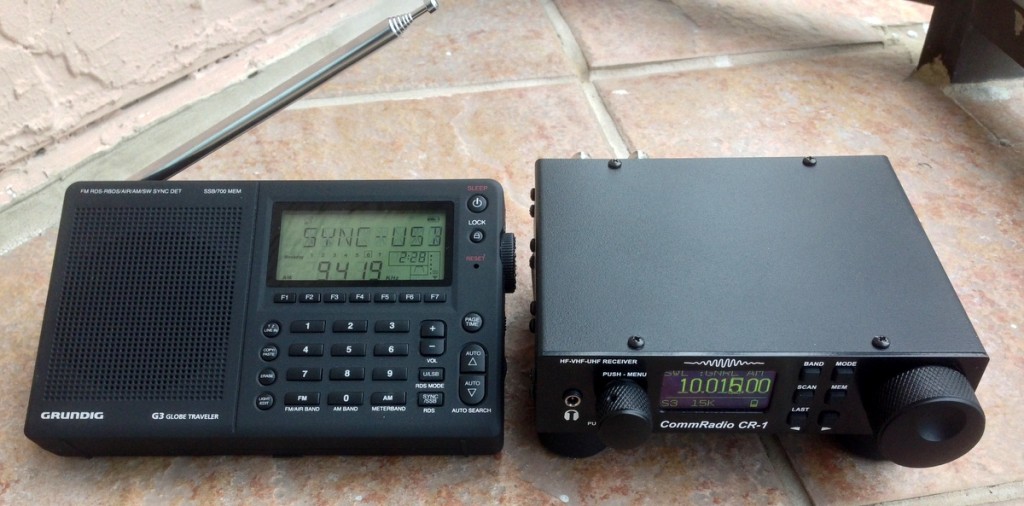
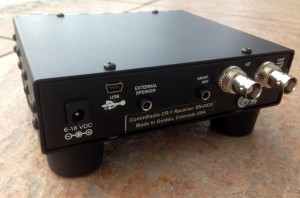
I am planning on purchasing the CR-1 in the near future. I need advice on what kind of antenna I need to receive all bands on this radio. Will I need 2 antennas? Space is no problem. I don’t want to break the bank but I’m willing to pay a little more to get excellent coverage. Any suggestions would be appreciated..
Bob: since you have space, making a simple wire antenna for HF is a breeze and costs very little. Universal Radio has a long list of pre-made wire antennas that are resonant across the bands: http://universal-radio.com/catalog/sw_ant.html
I like the Par EF SWL and have used it quite a lot (it must be grounded).
Of course, like me, you can build a simple wire antenna and get by without investing much more than $20 or so for supplies. Here’s a YouTube video of a fellow building a simple longwire antenna as an example: https://www.youtube.com/watch?v=X8alRMVMG4g
My main SWL antenna is a large skyloop antenna I built from wire, ladder line and coax.
Universal also has books with plans for many types of wire antennas.
-Thomas
While all of the assorted effects appear to be functional, the reception with a whip antenna is a trifle underwhelming. I can pick up two local AM stations but that’s about it. Might need a more elaborate antenna, but then my CCRadio with a similar antenna picks up at least 50 AM stations.
David: your CommRadio is designed to be used with a proper wire external antenna. I have used a large telescopic whip in a pinch, but its front end is designed with an external antenna in mind. Your CCRadio, on the other hand, was designed to be used with a whip and internal ferrite bar for AM.
String up even a simple long wire antenna and that CR-1 will sing.
-Thomas
Lot of reviews of this receiver but NO ONE addresses memory. Does it have any?
Does anyone have info on how many software updates have been issued since the release of the CR-1 last summer ?
The latest updates for the CR-1 and also the CR-1aA are 9 months old, dated April 2014, available via links on the CommRadio website. For my CR-1 only several updates have been released, the latest updates DSP 1993 and PIC 1993 being the best as far as fixing problems. I have the feeling no more updates will be issued for the CR-1 but it’s possible there may be more for the CR-1A (but I wouldn’t hold my breath).
I recently acquired a second hand CR-1a. I really like the radio and find it to perform quite well overall. I am an old school guy who normally listens to the Ham SWL bands with the likes of an NRD-515. I detect a popping or crackling on voice peaks of strong SSB signals and CW. The noise ( clicking ) I hear with the audio may be a common thing, but need this verified before I raise a flag. This little SDR receiver blows me away and works great overall. Very pleased. However, I have a sensitive ear and I can hear something tha doesn’t belong on the audio peaks. Thanks Ray
Thanks for your time.
Ray WB8VDS
I have continued to run A/B comparisons between my CR-1a and an NRD-515. Digital to Analog competition. My NRD-515 has been a station favorite for many years. I find the two radios are pretty much equal in terms of performance. Sensitivity between the two are even. The wide range of BW filter options on the CR-1a are a real plus. My 515 has the stock 2.4 mechanical and the 500 hz cw filter. The CR-1a with the portability, long battery life and internal speaker makes this one awesome receiver. I plan to use this radio when camping and recharging via a small solar panel should be a snap. A small QRP transmitter with T/R switching is the works.
I was really blown away by receiving an email from the president of Comm Radio concerning feedback I left on their website.
Big performance in a small package. 5/5+
73’s
Ray WB8VDS
WITH POPULAR COMMUNICATIONS AND MONITORING TIMES NOW BOTH GONE RADIO BLOGS WILL BE THE MAIN IF NOT ONLY SOURCE OF INFORMATION LIKE THIS PRODUCT REVIEW
WITH POPULAR COMMUNICATIONS AND MONITORING TIMES BOTH GONE RADIO BLOGS ARE NOW THE MAIN IF NOT ONLY SOURCE OF INFORMATION LIKE THIS REVIEW
225mhz just happens to be the Digital One Multiplex shame the radio does not decode DAB or Digital Radio Mondale.
For me to add ISB , synchro narrower AM and SSB modes would be a good idea . However a signal meter in db and a memory of ca 4 GB for immediate recording could be for me something rather important !
or at least a slot for SD cards ..
i forgot to ask Whatis IQ??
Nice radio…but…thousands of amplifier chips available and this premium radio wheezes along at 0.8 watts output (probably at 10% THD too). What if I’d like to connect a decent mini speaker to it like the classic Radio Shack Minimus 7? I’d better also look for a separate amplifier! Agree with the “3/4 Blind” comment. Where’s the bass and treble (analog controls please) or a software controlled equalizer? All that processing power, but the audio section is half cooked.
Hams and pirates that broadcast in enhanced SSB are the reason I wish more SW radios offered the choice of narrow or wider bandwidth filters for LSB/USB, 4 kHz, 6 kHz, 8 kHz, 10 kHz. When there are no adjacent stations one can open up the bandwidth for improved fidelity. I understand that communications grade receivers emphasize signal isolation and voice intelligibility over audio fidelity; I wonder if a SW radio that has wide IF bandwidth has a stigma as cheap consumer grade radio, thus consequently shunned by manufacturers, while a SW radio, ahem, HF receiver with narrow IF bandwidth is regarded as serious SWL hobbyist’s “gear” thus embraced by manufacturers and traditionalist SWLer. My point is we are well into the 21st century where SDR is available to the masses. My question to the SWL and radio experts is: In an SDR is IF filter implementation still hardware driven? Or, are the filters realized through software? If the latter then it seems that adding more filters would be a matter of adding more lines of code at little additional cost. And as others have mentioned sideband selectable synchronous detection a la Sony ICF 2010 would be nice.
While I’m on an audio rant how about bass and treble controls. The Windows Media Player has a built in 10-band graphic equalizer as well as a dozen preset EQ settings. Heck, my Samsung LCD TV has a graphic equalizer. Why not a luxury radio? I’d also like a line level audio output jack. The Eton E5 has a line level output. The OLED looks nice. Glad to see OLEDs showing up in more consumer grade products.
When the CR1 first came out a few months ago I read of someone else commenting on the mediocre MW performance. I suspect that a high pass filter (MW attenuator) is bulit in to reduce the chance of overloading. This is a logical approach with a wide open front end like a budget SDR. You have to pay more for a SDR with appropriate bandpass filtering and a more crunch-proof front end, such as in my Perseus and (almost certainly) in your Excalibur also.
I’m planning to install a 4 square antenna at my house this winter. I hope to give all of my radios a little more medium wave time since I should have an antenna that can null out unwanted signals. (Currently I use a horizontal delta loop–which is omni-directional.) I should have a better report on the CR-1’s MW performance then.
When I first saw that the CR1 had extended VHF/UHF coverage (at least compared to other HF receivers in the ~$500 price class) I was very interested. It could have been an alternative to an Icom 8500 at 1/3 the price. Alas, it seems that the VHF/UHF section is an afterthought on the CR1, only single conversion with poor sensitivity to boot. For those interested in expanding their hobby from SWL to VHF, I’m not sure that the CR1 is your radio. I was disappointed, and I wonder if those considering a CR1 primarily for desktop SWL would be better off with something like a Satellit 750 or 909X (and then use some of the $350 saved for a good antenna)? Or go pro and get an Icom r75? Except for novelty, portability and maybe quality, I’m still not sure how the CR1 stands out.
I think the CR-1 holds its own as a shortwave receiver–to me, I prefer it over other similar tabletops because the size/performance ratio is so great (and portability). The VHF/UHF receive is more like a bonus, in my opinion and I really can’t comment on it since I just don’t spend a lot of time in that part of the spectrum.
Other than a radio like the Icom 8500, or some of the AOR offerings, I’m not a big believer in all-in-one radios. I do think the CR-1 would give listeners a chance to venture up to those bands, though. I can easily pick out local 2M repeaters and other VHF activity on the CR-1 where I live. In crowded conditions, I assume performance would be more compromised since it’s single conversion.
Thanks for the comments!
I do agree with you. I was considering the CR-1 worth of attention but
given its quite poor sensitivity at V/UHF I decided not to pull the trigger. Actually I’m covering the V/UHF portion with a simple RTL820 chipset USB dongle. it is more sensitive than the CR-1 in that range at the ridiculous cost of 20$.
It seems indeed a little but really interesting receiver for travel and DXpeditions. I don’t know if it’s possible to add other filters, but a narrower CW filter (250 kHz or so) would be great. Also, in some areas crowded by FM stations, a narrower filter (about 110 kHz) would make this receiver excellent for FM DXing.
for the DX’ing the MW (AM) band, how does it compare to, eg, the Sony icf-2010, Sony icf 7600gr, Sangean 909X or some of the older Zenith Transoceanics from the 1970’s? ………………Any feedback on these and is SDR the “wave of the future”?
If the above said is software defined (sans a computer), then why are more receivers not being offered such as this?
The development of powerful, battery conserving processors for mobile phones and tablets has enabled the CR1. This is something very recent.
I seriously want one of these. Really fits the niche it helped define.
Thanks for posting the review. I’ve had a CR-1 since mid-August and pretty much agree with your conclusions. The audio is one of the radio’s strongest points, and I find that the CR-1 has become my default radio for SW listening.
This looks like a wonderful product. Now I know what I will get in December!!!!!
Look’s great …. Seriously nice explanation